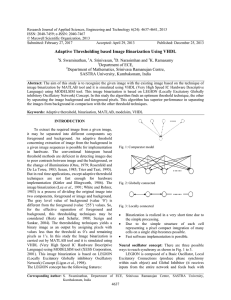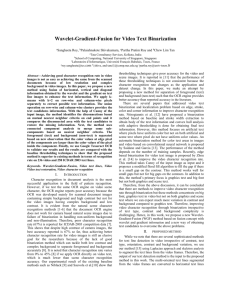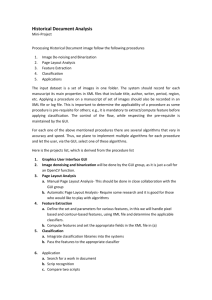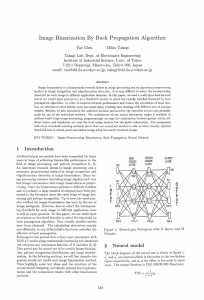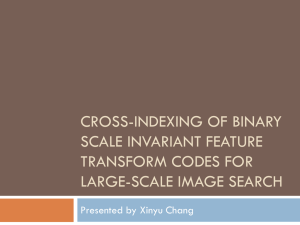www.ijecs.in International Journal Of Engineering And Computer Science ISSN: 2319-7242
advertisement
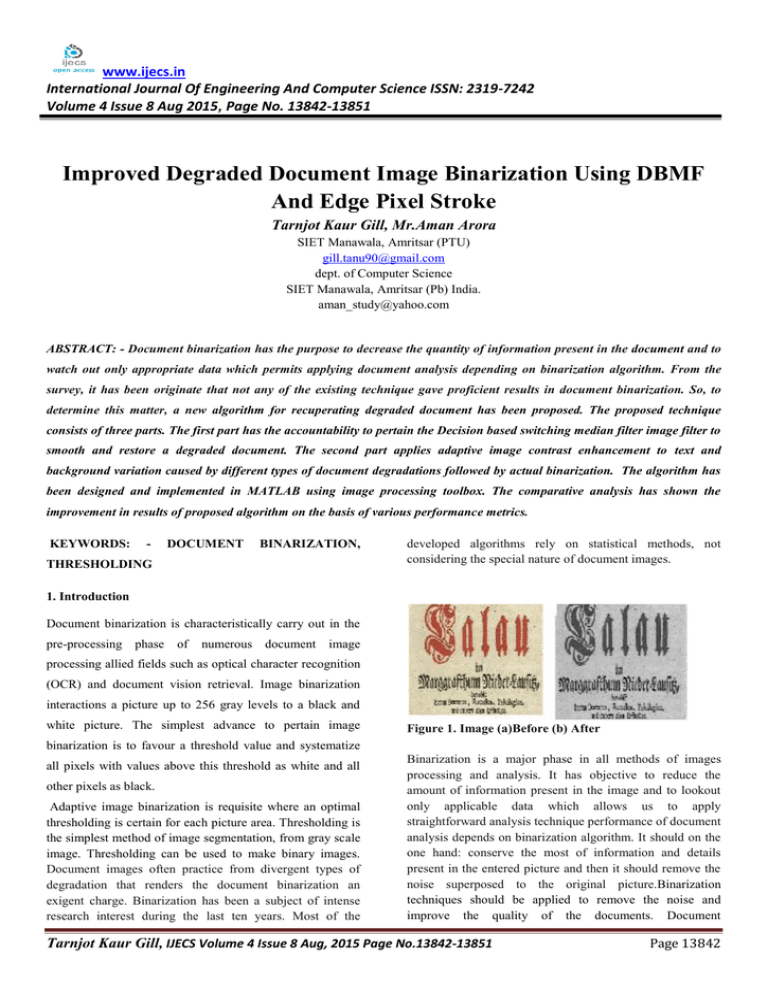
www.ijecs.in International Journal Of Engineering And Computer Science ISSN: 2319-7242 Volume 4 Issue 8 Aug 2015, Page No. 13842-13851 Improved Degraded Document Image Binarization Using DBMF And Edge Pixel Stroke Tarnjot Kaur Gill, Mr.Aman Arora SIET Manawala, Amritsar (PTU) gill.tanu90@gmail.com dept. of Computer Science SIET Manawala, Amritsar (Pb) India. aman_study@yahoo.com ABSTRACT: - Document binarization has the purpose to decrease the quantity of information present in the document and to watch out only appropriate data which permits applying document analysis depending on binarization algorithm. From the survey, it has been originate that not any of the existing technique gave proficient results in document binarization. So, to determine this matter, a new algorithm for recuperating degraded document has been proposed. The proposed technique consists of three parts. The first part has the accountability to pertain the Decision based switching median filter image filter to smooth and restore a degraded document. The second part applies adaptive image contrast enhancement to text and background variation caused by different types of document degradations followed by actual binarization. The algorithm has been designed and implemented in MATLAB using image processing toolbox. The comparative analysis has shown the improvement in results of proposed algorithm on the basis of various performance metrics. KEYWORDS: - DOCUMENT BINARIZATION, THRESHOLDING developed algorithms rely on statistical methods, not considering the special nature of document images. 1. Introduction Document binarization is characteristically carry out in the pre-processing phase of numerous document image processing allied fields such as optical character recognition (OCR) and document vision retrieval. Image binarization interactions a picture up to 256 gray levels to a black and white picture. The simplest advance to pertain image Figure 1. Image (a)Before (b) After binarization is to favour a threshold value and systematize all pixels with values above this threshold as white and all other pixels as black. Adaptive image binarization is requisite where an optimal thresholding is certain for each picture area. Thresholding is the simplest method of image segmentation, from gray scale image. Thresholding can be used to make binary images. Document images often practice from divergent types of degradation that renders the document binarization an exigent charge. Binarization has been a subject of intense research interest during the last ten years. Most of the Binarization is a major phase in all methods of images processing and analysis. It has objective to reduce the amount of information present in the image and to lookout only applicable data which allows us to apply straightforward analysis technique performance of document analysis depends on binarization algorithm. It should on the one hand: conserve the most of information and details present in the entered picture and then it should remove the noise superposed to the original picture.Binarization techniques should be applied to remove the noise and improve the quality of the documents. Document Tarnjot Kaur Gill, IJECS Volume 4 Issue 8 Aug, 2015 Page No.13842-13851 Page 13842 DOI: 10.18535/ijecs/v4i8.41 binarization is a useful and basic step of the image analysis systems. When applied, it converts gray-scale document images to black and white (binary) ones. In the transformed binary image the background is represented by white pixels and the text by black ones. 2. Gradient magnitude: Image gradients can be used to take out information from images. Gradient images are formed from the original image. Each pixel of a gradient image processes the change in intensity of that similar point in the original image, in a given direction. To acquire the full range of direction, gradient images in the x and y directions are calculated. One of the mainly general uses is in edge detection. Once gradient images have been calculated, pixels with large gradient values turn into feasible edge pixels. The pixels with the leading gradient values in the direction of the gradient turn into edge pixels, and edges may be traced in the direction perpendicular to the gradient direction. One example of an edge detection algorithm that uses gradients is the canny edge detector. Image gradients can also be used for vigorous feature and texture matching. Dissimilar lighting or camera properties can cause two images of the similar scene to have radically different pixel values. This can affect matching algorithms to not succeed to match very similar or identical features. One way to work out this is to compute texture or feature signatures based on gradient images computed from the original images. These gradients are less vulnerable to lighting and camera changes, so matching errors are condensed the gradient of an image course how it is changing. It gives two pieces of information. The magnitude of the gradient tells us how quickly the image is changing, while the direction of the gradient tells us the direction in which the image is changing most quickly. To demonstrate this, assume of an image as like a landscape, in which at each point we are given a height, rather than intensity. For any point in the landscape, the direction of the gradient would be the direction uphill. The magnitude of the gradient would tell us how rapidly our height increases when we take a very small step uphill. 3. Contrast adjustment: Contrast adjustment advance the perceptibility of objects in the scene by attractive the brightness distinction between objects and their backgrounds. Contrast enhancements are usually carried out as a contrast stretch followed by a tonal enhancement, though these could both be executed in one step. A contrast stretch advanced the brightness distinctions uniformly transversely the dynamic range of the image, while tonal enhancements advance the brightness differences in the shadow, midtone , or highlight regions at the cost of the brightness differences in the other regions. Contrast enhancement progressions amend the relative brightness and darkness of objects in the scene to advance their visibility. The contrast and tone of the image can be changed by mapping the gray levels in the image to new values through a gray-level transform. The mapping function reassigns the current gray level GL to a new gray level GL 4. Noise image: Noise is a casual deviation of image Intensity and noticeable as grains in the image. It may occur in the image as possessions of basic physics-like photon nature of light or thermal energy of heat inside the image sensors. It may generate at the time of capturing or image transmission. Noise means, the pixels in the image show different intensity values in its place of true pixel values. Noise removal algorithm is the procedure of eliminate or dropping the noise from the image. The noise removal algorithms condense or eliminate the visibility of noise by smoothing the entire image leaving areas near contrast boundaries. But these methods can ambiguous fine, low contrast details. The common types of noise that occur in the image are a) Impulse noise, b) Additive noise [1]) Multiplicative noise. Different noises have their own features which make them discernible from others. Noise is commenced in the image at the time of image acquisition or transmission. Different reasons may be accountable for preamble of noise in the image. The amount of pixels infected in the image will choose the quantification of the noise. The principal sources of noise in the digital image are: a) the imaging sensor may be pretentious by environmental conditions at some point in image acquisition. b) Insufficient Light levels and sensor temperature may commence the noise in the image. c) Intervention in the transmission channel may also distort the image. d) If dust particles are present on the scanner screen, they can also introduce noise in the image. Segmentation of text from badly degraded document an image is very challenging tasks due to the high inter/intravariation between the document background and the foreground text of different document images. In this paper, a novel document image binarization technique that addresses these issues by using adaptive image contrast. The adaptive image contrast is a combination of the local image contrast and the local image gradient that is tolerant to text and background variation caused by different types of document degradations. In the proposed technique, an adaptive contrast map is first constructed for an input degraded document image. The contrast map is then Binarized and combined with Canny’s edge map to identify the text stroke edge pixels. The document text is further segmented by a local threshold that is estimated based on the intensities of detected text stroke edge pixels within a local window. The proposed method is simple, robust, and involves minimum parameter tuning. It has been tested on three public datasets that are used in the recent document image binarization contest (DIBCO) 2009 & 2011 and handwritten-DIBCO 2010 and achieves accuracies of Tarnjot Kaur Gill, IJECS Volume 4 Issue 8 Aug, 2015 Page No.13842-13851 Page 13843 DOI: 10.18535/ijecs/v4i8.41 93.5%, 87.8%, and 92.03%, respectively that are significantly higher than or close to that of the best performing methods reported in the three contests. Experiments on the Beckley diary dataset that consists of several challenging bad quality document images also show the superior performance of this method, compared with other techniques. 6. Literature Survey Biswas, S et al(2014)[1] have proposed binarization technique of map document images. It exploits an amalgam of global and local threshold approaches best suited for binarization of document images with complex background and overlapping objects in the foreground like maps. This approach uses Distance Transform (DT) and Adaptive threshold. Initially a rough estimate of the map background is done using Distance Transform (DT). This is followed by an adaptive threshold operation to extract the foreground. The efficacy and accuracy of the proposed technique are also compared, using ICDAR 2009 -- DIBCO (Document Image Binarization Contest) evaluation parameters, with other algorithms already reported in the literature Zemouri, E.T.-T. et al(2014)[2] have proposed the use of the Contourlet Transform for evaluating the quality of the degraded historical document. To facilitate the binarization, they first improve the quality of the document image by applying the Contourlet Transform, in order to select significant coefficients. After reconstruction, a local thresholding method is used for extracting the foreground text. This method is evaluated on the benchmarking dataset used in the international document image binarization contest (DIBCO 2009/2011 and H-DIBCO 2010/2012) according to the type of degradation. Promising results are obtained comparatively to the standard methods. Somasundaram, K. et al(2014)[3] have proposed Segmentation of hippocampus (Hc) from the human brain is a significant task in the medical field for the identification of abnormalities in the brain functions. They have proposed a method to segment the hippocampus from Magnetic Resonance Imaging (MRI) of human brain scans. The pipeline of the proposed method makes use of filters such as trimmed mean and top-hat to blur and highlight the hippocampal edges respectively. The K-means clustering is used to find the threshold value in order to convert the filtered image into a binary one. The jaccard (J) and dice (D) indices are used to quantify the performance of the proposed method as well as the semi-automatic method ITK-SNAP. The results show that the proposed method works better than the existing ITK-SNAP. Parker, J. et al(2013)[4] have proposed often documents of historic significance are discovered in a state of disrepair. Such documents are commonly scanned to simultaneously archive and publicize a discovery. Converting the information found within such documents to public knowledge occurs more quickly and cheaply if an automatic method to enhance these degraded documents is used instead of enhancing each document image by hand. We describe a novel automated image enhancement approach that requires no training data. The approach is applicable to images of typewritten text as well as hand written text or a mixture of both. The pair of parameters used by the approach is automatically self-tuned according to the input image. The processing of a set of historic documents stored at Yad Vashem Holocaust Memorial Museum in Israel and selected images from the 2011 DIBCO test collection illustrate the approach. Hebert et al(2013)[5] have proposed Document image binarization is still an active research area as shows the number of binarization techniques proposed since many decades. The binarization of degraded document images is still difficult and encourages the development of new algorithms. For the last decade, discrete conditional random fields have been successfully used for many domains such as automatic language analysis. In this paper, we propose a CRF based framework to explore the combination capabilities of this model by combining discrete outputs from several well known binarization algorithms. The framework uses two 1D CRF models on the horizontal and the vertical directions that are coupled for each pixel by the product of the marginal probabilities computed from the both models. Experiments are made on two datasets from the Document Image Binarization Contest (DIBCO) 2009 and 2011 and show best performances than most of the methods presented at DIBCO 2011. Milyaev et al (2013)[6] have proposed modern off-the-shelf OCR engines show particularly high accuracy on scanned text, text detection and recognition in natural images still remains a challenging problem. They demonstrate that OCR engines can still perform well on this harder task as long as appropriate image binarization is applied to input photographs. For such binarization, they systematically evaluate the performance of 12binarization methods as well as of a new binarization algorithm that we propose here. Their evaluation includes different metrics and uses established natural image text recognition benchmarks (ICDAR 2003 and ICDAR 2011).the fact that image binarization methods combined with additional filtering of generated connected components and off-theshelf OCR engines can achieve state- of-the-art performance for end-to-end text understanding in natural images. Tarnjot Kaur Gill, IJECS Volume 4 Issue 8 Aug, 2015 Page No.13842-13851 Page 13844 DOI: 10.18535/ijecs/v4i8.41 Bolan Su et al. (2013) [7] have proposed a novel document image binarization technique that concentrates on these issues by using adaptive image contrast. An adaptive contrast map is first assembling for an input degraded document image. The contrast map is then Binarized and collective with Canny's edge map to identify the text stroke edge pixels. The document text is additional segmented by a local threshold that is approximate based on the intensities of detected text stroke edge pixels within a local window. The Beckley diary dataset that consists of numerous tricky bad quality document images also show the superior performance of proposed method, compared with other techniques. Bolan Su et al. (2013) [8] have proposed Document Image Binarization is a method to segment text out from the background region of a document image, which is a challenging task due to high intensity variations of the document foreground and background. They have proposed a self learning classification framework that combines binary outputs of different binarization methods. The proposed framework makes used of the sparse representation to re-classify the document pixels and generate a better binary results. Wagdy et al. (2013) [9] have proposed that alteration from gray scale or colour document image into binary image is the main and significant step in most of optical character recognition (OCR) systems and document analysis. Most of the preceding binarization methods that depend on local thresholding consume more time. They present fast and efficient document image clean up and binarization method based on retinex theory and global threshold. The proposed method is fast and generates high quality results compared to the previous works. Rabeux et al. (2013) [10] have proposed an approach to expect the result of binarization algorithms on a given document image according to its state of degradation. Historical documents experience from different types of degradation which result in binarization errors. They have proposed to characterize the degradation of a document image by using different features based on the intensity, quantity and location of the degradation. These features allow us to build prediction models of binarization algorithms that are very accurate according to R2 values and p-values. The forecast models are used to pick the best binarization algorithm for a given document image. This image-by-image strategy improves the binarization of the whole dataset. GACEB et al. (2013) [11] have proposed the automatic reading systems of business documents requires fast and precise reading of interest zones using the OCR technology. The quality of each pixel is predictable using a hierarchical local thresholding in order to classify it as foreground, background or ambiguous pixel. The global quality of the image is thus predictable from the density of theses degraded pixels. If it is considered as degraded, we apply a second separation on the ambiguous pixels to separate them into background or foreground. This second process uses our improved relaxation method that we have accelerate for the first time to integrate it into a system of automatic reading document. Compared to existing binarization approaches (local or global), offers a better reading of characters by the OCR. Seki et al. (2013) [12] have proposed a novel method using "color drop-out" for document images with "color shift" is proposed. Color shift phenomena occasionally arise in document images captured by a camera device or stand type scanner. It unfavourably affects the binarization and character recognition processes, because it generates pseudo color pixels on scanned image, which do not exist on the original document. To solve the "pseudo color problem," a binarization method based on the following three calculation steps is proposed. First, line and character areas are estimated coarsely by using form structure analysis and subtracting background from images, second, the color shift is detached by using morphological processing, third, each pixel of the background subtracted images is discriminated into character strings and lines accurately by dynamic color classification. Smith et al. (2012) [13] have discussed that Image binarization has a great outcome on the rest of the document image analysis processes in character recognition. The preference of binarization ground truth affects the binarization algorithm design, either directly if design is by automated algorithm trying to contest the provided ground truth, or indirectly if human designers adjust their designs to execute better on the provided data. Three variations in pixel accurate ground truth were used to train a binarization classifier. The performance can differ considerably depending on choice of ground truth, which can manipulate binarization design choices. Papavassiliou et al. (2012) [14] have proposed that Document image binarization is an original though critical stage towards the recognition of the text components of a document. The method is based on mathematical morphology for extracting text regions from degraded handwritten document images. The basic stages of our approach are: (a) top-hat-by-reconstruction to produce a filtered image with reasonable even background, (b) region growing starting from a set of seed points and attaching to each seed similar intensity neighbouring pixels and (c) conditional extension of the initially detected text regions based on the values of the second derivative of the filtered image. Tarnjot Kaur Gill, IJECS Volume 4 Issue 8 Aug, 2015 Page No.13842-13851 Page 13845 DOI: 10.18535/ijecs/v4i8.41 Pratikakis et al. (2012) [15] have proposed that H-DIBCO 2012 is the International Document Image Binarization Competition which is devoted to handwritten document images structured in conjunction with ICFHR 2012 conference. The objective of the contest is to recognize existing advances in handwritten document image binarization using significant estimation performance measures. Bolan Su et al. (2012) [16] have proposed that document image binarization is a significant pre-processing technique for document image analysis that segments the text from the document image backgrounds. They have propose a learning framework that makes use of the Markov Random Field to advance the performance of the existing document image binarization methods for those degraded document images. Extensive experiments on the recent Document Image Binarization Contest datasets express that significant enhancement of the existing binarization methods when applying our proposed framework. Le, T.H.N et al. (2011) [17] have proposed an enormous number of historical and badly degraded document images can be found in libraries, public, and national archives. A novel adaptive binarization algorithm using ternary entropy-based approach has been proposed. The pixels in the second region are relabelled by the local mean and the standard deviation. This method classifies noise into two categories which are processed by binary morphological operators, shrink and swell filters, and graph searching strategy. The estimation is based upon nine distinct measures. The proposed algorithm outperforms other state-of-the-art methods. F-measure is determining a test's accuracy. It consider both the precision p and the recall r of the test to compute the score: p is the number of accurate results divided by the number of all returned results and r is the number of accurate results divided by the number of results that should have been returned.The F-measure can be understand as a weighted average of the precision and recall, where an F1 score arrive at its best value at 1 and worst score at 0. The traditional F-measure is the harmonic mean of precision and recall: 𝐹1 = 2. precision . recall precision + recall Bit Error Rate: A bit error rate is defined as the rate at which errors occur in a transmission system. This can be directly translated into the number of errors that occur in a string of a stated number of bits. The definition of bit error rate can be translated into a simple formula: BER = 𝐍𝐮𝐦𝐛𝐞𝐫 𝐨𝐟 𝐞𝐫𝐫𝐨𝐫𝐬 𝐓𝐨𝐭𝐚𝐥 𝐧𝐮𝐦𝐛𝐞𝐫 𝐨𝐟 𝐭𝐚𝐫𝐧𝐬𝐦𝐢𝐭𝐭𝐞𝐝 𝐛𝐢𝐭𝐬 ….4 Geometry Accuracy: Accuracy is the capacity acceptance, or transmission of the mechanism and describe the restrictions of the errors made when the mechanism is used in normal operating conditions, Accuracy is also used as a arithmetical evaluate of how well a binary classification test properly recognize or reject a condition. The accuracy is the quantity of proper results in the population. To create the situation clear by the semantics, it is often referred to as the "Rand Accuracy". It is a parameter of the test. Here T.P is defined as true positives, T.N is defined as true negatives, F.P is defined as false positives and F.N is defined as false negatives. accuracy = 7. Performance Metrics Performance is measured using the parameters such as Precision, F-measure, Bit Error Rate, and Geometry Accuracy. 𝐧𝐮𝐦𝐛𝐞𝐫 𝐨𝐟 𝐭. 𝐩 + 𝐧𝐮𝐦𝐛𝐞𝐫 𝐨𝐟 𝐭. 𝐩 𝐧𝐮𝐦𝐛𝐞𝐫 𝐨𝐟 𝐭. 𝐩 + 𝐟. 𝐩 + 𝐟. 𝐧 + 𝐭. 𝐧 8. Experimental results: Precision: Precision is the fraction of retrieved instances that are relevant, the precision for a class is the number of true positives (i.e. the number of items correctly labelled as belonging to the positive class) divided by the total number of elements labelled as belonging to the positive class (i.e. the sum of true positives and false positives, which are items incorrectly labelled as belonging to the class). Precision= Design and implementation is done in MATLAB by using Image Processing Toolbox. This image enhancement approach is tested on different 12 images of different format and size. We have shown the results on image 4. Fig 8.1 is showing the input image for experimental analysis 𝐍𝐮𝐦𝐛𝐞𝐫 𝐨𝐟 𝐭𝐫𝐮𝐞 𝐩𝐨𝐬𝐢𝐭𝐢𝐯𝐞𝐬 𝐍𝐮𝐦𝐛𝐞𝐫𝐬 𝐨𝐟 𝐭𝐫𝐮𝐞 𝐩𝐨𝐬𝐢𝐭𝐢𝐯𝐞𝐬+𝐟𝐚𝐥𝐬𝐞 𝐩𝐨𝐬𝐢𝐭𝐢𝐯𝐞𝐬 F-measure: Tarnjot Kaur Gill, IJECS Volume 4 Issue 8 Aug, 2015 Page No.13842-13851 Page 13846 DOI: 10.18535/ijecs/v4i8.41 Fig 8.1 Input Image Fig 8.4 Base paper Fig 8.4 has shown the output image taken by base paper method. 9. Proposed algorithm Fig8.2 Contrast Adjusted Image Fig 8.2 has shown the output image taken by contrast adjusted. The output image has better contrast and has shown other details. Figure 1 has shown the proposed algorithm’s flowchart. Subsequent are the various steps required to accomplish this research work. Step 1: First of all a document image will be taken for experimental purpose. Step 2: If the input image is a color image then it will be converted into a gray scale one. Step 3: Apply the Decision based switching median filter to smooth and restore the input document image. Step 4: Now adaptive image contrast enhancement will come in act in order to improve the contrast of the input image. Step 5: Now contrast map of the input image will be Binarized using adaptive thresholding and it is integrated with Hybrid edge map to identify the text stroke edge pixels. Step 6: Apply morphological operations to convert the image into a final Binarized image. Fig8.3 Gradient Magnitude Fig 8.3 has shown the output image taken by gradient magnitude. Tarnjot Kaur Gill, IJECS Volume 4 Issue 8 Aug, 2015 Page No.13842-13851 Page 13847 DOI: 10.18535/ijecs/v4i8.41 Test images 1 2 3 4 5 6 7 8 9 10 11 12 Basepaper 0.71233 0.99061 0.84610 0.93156 0.98444 0.43461 0.81409 0.99008 0.97566 0.86247 0.99371 0.93156 Proposed method 0.71949 0.98255 0.82292 0.89352 0.97253 0.65640 0.96994 0.96042 0.95210 0.90150 0.98666 0.89503 Graph 6.1: Precision of thresholding Stretching and base paper for different images It is very clear from the plot that there is decrease in precision value of images with the use of base paper method over other methods. This decrease represents improvement in the objective quality of the image. 9. Performance analysis This section contains the cross validation between base paper and other techniques. Some well-known image performance metrics for digital images have been selected to prove that the performance of the base paper is quite better than the other methods. 9.1 Precision: Table 1: Precision F-measure: Table 8.2 is showing the quantized analysis of F-measure. As F-measure need to be increased therefore the proposed method is showing the better results than the base paper methods as F-measure is greater in every case. Table 2 F-measure Test images 1 2 3 4 5 Basepaper 78.81587 89.17925 91.49786 88.92460 78.17259 Tarnjot Kaur Gill, IJECS Volume 4 Issue 8 Aug, 2015 Page No.13842-13851 Proposed method 82.36925 98.34192 90.28476 93.68474 95.30946 Page 13848 DOI: 10.18535/ijecs/v4i8.41 6 7 8 9 10 11 12 58.09176 76.65198 79.13189 75.88616 88.11086 92.13071 88.48286 77.23898 97.12995 96.44152 94.21303 93.60653 98.69697 93.76943 It is very clear from the plot that there is decrease in precision value of images with the use of base paper method over other methods. This decrease represents improvement in the objective quality of the image 3 Bit Error Rate: Bit Error Rate (BER) It is very clear from the plot that there is decrease in bit error rate value of images with the use of proposed method over other methods. This decrease represents improvement in the objective quality of the image. Geometry Accuracy: Table 9.4 is showing the quantized analysis of bit error rate. As Geometry accuracy need to be increased therefore the proposed method is showing the better results than the base paper methods as geometry accuracy is greater in every case. Table 9.3 is showing the quantized analysis of bit error rate. As BER need to be reduced therefore the proposed method is showing the better results than the base paper methods as BER is less in every case. Table 4: Geometry Accuracy Table 3: BER Test images 1 2 3 4 5 6 7 8 9 10 11 12 Proposed method Test images Basepaper Basepaper 7.28726 9.49476 1.42907 7.71868 17.61709 15.25314 15.45748 17.06907 19.04799 5.79775 7.10265 8.24912 3.18617 0.85868 1.41294 1.14893 3.32864 9.06086 1.62094 1.65415 3.54566 1.90617 0.71971 1.33201 1 2 3 4 5 6 7 8 9 10 11 12 0.92603 0.90014 0.98565 0.91998 0.80490 0.84700 0.83669 0.81164 0.78724 0.94111 0.92631 0.91444 Tarnjot Kaur Gill, IJECS Volume 4 Issue 8 Aug, 2015 Page No.13842-13851 Proposed method 0.96813 0.99139 0.98577 0.98850 0.96617 0.90894 0.98373 0.98334 0.96401 0.98091 0.99279 0.98668 Page 13849 DOI: 10.18535/ijecs/v4i8.41 Systems (DAS), 2014 11th IAPR International Workshop on. IEEE, 2014. [2] Zemouri, E., Youcef Chibani, and Youcef Brik. "Restoration based Contourlet Transform for historical document binarization." Multimedia Systems (ICMCS), image Computing 2014 and International Conference on. IEEE, 2014. [3] Somasundaram, K., and T. Genish. "The extraction of hippocampus from MRI of human brain using morphological and image Graph 9.4: Geometry Accuracy of thresholding Stretching and base paper for different images binarization techniques."Electronics It is very clear from the plot that there is increase in geometry accuracy value of images with the use of proposed method over other methods. This increase represents improvement in the objective quality of the image. International Conference on. IEEE, 2014. Communication [4] (ICECS), 2014 Parker, Julian, Ophir Frieder, and Gideon Frieder. "Automatic Binarization CONCLUSION: Systems and of Enhancement Degraded and Document Images." Document Analysis and Recognition The main objective of this paper is to apply the Decision based switching median filter to smooth and restore a degraded document. Moreover adaptive image contrast enhancement has been utilized in order to improve the contrast of the input image. The contrast map of the input image has been binarized using adaptive thresholding and then integrated with Hybrid edge map (i.e. Canny’s and Laplacian’ edge map) to identify the text stroke edge pixels. Moreover various morphological operations have been used to convert the image into a final binarized image. The algorithm has been designed and implemented in MATLAB. An experimental result has shown the improvement of the proposed algorithm on the basis of various parameters compared to the existing technique. (ICDAR), 2013 12th International Conference on. IEEE, 2013. [5] Su, Bolan, Shijian Lu, and Chew Lim Tan. "Robust document technique for image binarization degraded document images." Image Processing, IEEE Transactions on 22.4 (2013): 1408-1417. [6] Su, Bolan, et al. "Self Learning Classification for Degraded Document Images by Sparse Representation." Document Analysis and Recognition (ICDAR), 2013 12th International Conference on. IEEE, 2013. In near future, we will use multilevel thresholding technique to enhance the binarization rate further. Further enhancement can also be done by using the genetic algorithm based binarization. This work has considered only document images, so in near future, other kind of images can also be considered. [7] Wagdy, M., Faye, and DayangRohaya. "Fast and efficient document image clean up and binarization based on retinex theory." Signal Processing and its Applications REFRENCES [1] Ibrahima (CSPA), 2013 IEEE 9th International Colloquium on. IEEE, 2013 Biswas, Santosh, et al. "Land Map Images [8] Rabeux, Vincent, et al. "Quality evaluation of Binarization Based on Distance Transform and ancient digitized documents for binarization Adaptive prediction." Document Threshold." Document Analysis Tarnjot Kaur Gill, IJECS Volume 4 Issue 8 Aug, 2015 Page No.13842-13851 Analysis and Page 13850 DOI: 10.18535/ijecs/v4i8.41 Recognition (ICDAR), 2013 12th International [9] Su, Bolan, Shijian Lu, and Chew Lim Tan. Conference on. IEEE, 2013. "Combination of document image binarization Gaceb, Djamel, Frank Lebourgeois, and Jean techniques." Document Duong. Recognition (ICDAR), 2011 International "Adaptative Method: For Smart-Binarization Images Documents." Document [10] [16] of Business Analysis and Analysis and Conference on. IEEE, 2011. [17] Shaikh, SoharabHossain, AsisMaiti, and Recognition (ICDAR), 2013 12th International NabenduChaki. "Image Conference on. IEEE, 2013. iterative partitioning: A global thresholding Seki, Minenobu, et al. "Color Drop-Out approach." Recent Binarization Method for Document Images Systems with Color Shift." Document Analysis and Conference on. IEEE, 2011. binarization using Trends (ReTIS), 2011 in Information International Recognition (ICDAR), 2013 12th International Conference on. IEEE, 2013 [11] Smith, Elisa H. Barney, and Chang An. "Effect of" ground truth" binarization." Document (DAS), 2012 10th on image Analysis Systems IAPR International Workshop on. IEEE, 2012. [12] Papavassiliou, Vassilis, et al. "A Morphology Based Approach Handwritten Handwriting for Binarization Documents." Frontiers Recognition (ICFHR), of in 2012 International Conference on. IEEE, 2012. [13] Pratikakis, Konstantinos Ioannis, Basilis Ntirogiannis. Gatos, "ICFHR and 2012 competition on handwritten document image binarization (H-DIBCO 2012)."Frontiers in Handwriting Recognition (ICFHR), 2012 International Conference on. IEEE, 2012. [14] Su, Bolan, Shijian Lu, and Chew Lim Tan. "A learning framework for degraded document image binarization using Markov random field." Pattern Recognition (ICPR), 2012 21st International Conference on. IEEE, 2012. [15] Le, T. Hoang Ngan, Tien D. Bui, and Ching Y. Suen. "Ternary entropy-based binarization of degraded document images using morphological operators."Document Analysis and Recognition (ICDAR), 2011 International Conference on. IEEE, 2011. Tarnjot Kaur Gill, IJECS Volume 4 Issue 8 Aug, 2015 Page No.13842-13851 Page 13851
